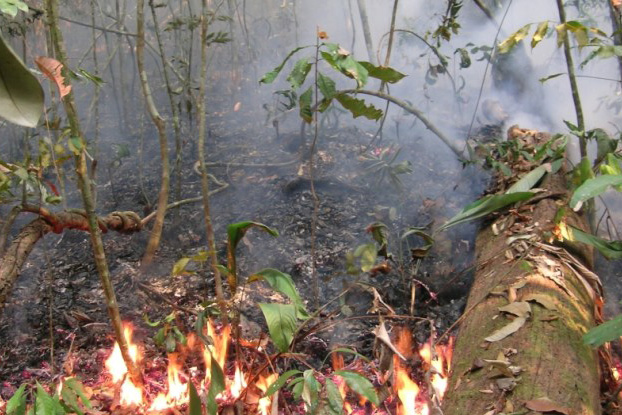
By Samuel Mcglennon, originally published at CIFOR’s Forests News
Nearly one million square kilometers of land in Brazil are currently designated as ‘Sustainable Use Reserves’ (SURs).
However, a new study shows that these reserves are failing to address one of the Amazon’s biggest threats- fire.
“Our research reveals that these reserves don’t affect the timing, frequency or density of fires that occur within them,” said Rachel Carmenta, lead author of the study and a scientist at the Center for International Forestry Research (CIFOR).
“In the context of extending fire seasons globally, and continued regional development, there is some urgency for efforts to improve the performance of sustainable use reserves.”
Evaluation of the performance of reserves in the Amazon previously used metrics of deforestation that largely ignored the dynamics before and after reserve creation. For this reason, there are limited studies today that explicitly focus on ‘Sustainable Use Reserves’, despite the fact that they are proliferating.
What’s more, while indigenous reserves are often characterised by low population densities, SURs can be created in areas adjacent to modest population centers.
“By their very nature, ‘sustainable use reserves’ have people living within them when they are created,” said Carmenta. “These are often people practicing small-scale agriculture, so reserves have a dual objective to promote conservation while also allowing sustainable livelihoods to continue.”
Fire is inextricably linked to each of these objectives because many people’s livelihoods within the reserves are based on smallholder agriculture, in which fire plays a central role.
Comparisons in space and through time
Carmenta and her colleagues thus set out to disentangle the landscape determinants of fire in reserves (i.e. location factors) from the actual policy change of reserve creation on fire density.
“We first examined the frequency of fires within reserves compared to the buffer zones and the extent to which landscape factors like population density determined fire events,” she said. “Our findings show that the landscape factors are the most important determinants of fire.”
While verifying their findings, the scientists realized that they could take a further analytical step- one that is rarely used in analyzing reserve performance.
“Ultimately, we showed that the act of creating reserves does not have an impact on fire patterns. Instead, what is more important are the other factors like population density and connectivity.”
This means that as far as fire management is concerned, where one places a reserve is actually more important than the actual act of designating one.
Tweaking fire management
When the scientists set out to analyze the performance of reserves with respect to fire, they thought that they might find evidence for shifts towards less risky burns following reserve creation. They collected information on rainfall events and fire and examined whether there was evidence towards less risky burns (i.e. burns decoupled from peak dry days) after the reserve was established.
What they found was surprising.
“Reserve creation did not induce any shift towards improved fire management by SUR residents [i.e. in the form of less risky burnings],” said Carmenta.
The study’s findings show the asymmetry of the relationship between reserves and fire. Fires remain one of the greatest threats to the reserves and their inhabitants, yet they currently have no discernible impact on fire management within their boundaries.
While reluctant to offer solution options that are not evidence-based, Carmenta says there are relatively simple things that can be done to improve the situation.
Part of what’s missing is relevant weather forecasts and information on climatic conditions.
“These might not be needed every year, but in dangerous years like El Niño years, a targeted provision of this information could be really valuable.”
Carmenta also sees a role for rural extension services in helping reduce smallholders’ reliance on fire-based agricultural techniques.
“Smallholder fire use is a long-established practice and so far, the policy and legislation used to manage and control fires in the Amazon have not managed to fit the local realities and context in a way that allows for policy uptake at the local level.
“Smallholders need better extension services to help them gain access to the technology, knowledge and capacity to take up agricultural practices that rely less heavily on fire. But it’s difficult to imagine these services being rolled out across the entire Amazon, so it will be necessary to prioritize between the level of fire risk and interventions that can be done quickly, cheaply and effectively,” she said.
The study shows that ‘Sustainable Use Reserves’ clearly need further attention.
“The big message for governments is that these reserves really aren’t performing when it comes to reducing fire threats,” said Carmenta.
What’s more, the determinants of fire risk identified by the study show that reserves will require more support in future.
“We find that the reserves most at risk have two common characteristics: higher population densities and greater connectivity, in particular by rivers.”
With a planned network of roads extending throughout the Amazon, greater terrestrial connectivity will prove increasingly important.
The study used relatively novel methodological approaches to arrive at its findings. Even the decision to focus on fire is a key point of differentiation between this and previous studies, which used hunting or deforestation as proxies for determining reserve performance.
Another key contribution of this study was its ‘before and after’ comparison model, which enabled a glimpse of the changes – or lack thereof- that follow the policy change of reserve creation.
“Previous studies by in large didn’t use a temporal approach when exploring the impacts of reserves,” said Carmenta. “It would be great to use this approach to analyze the performance of other reserves, or expand research to include a comparative analysis across the reserves of the tropics all around the world.”
“We hope this study will highlight our concern over methods that didn’t take a ‘before and after approach’, which is helpful when assessing reserve performance borne by reserve creation as distinct from the landscape determinants of reserve performance,” she added.











